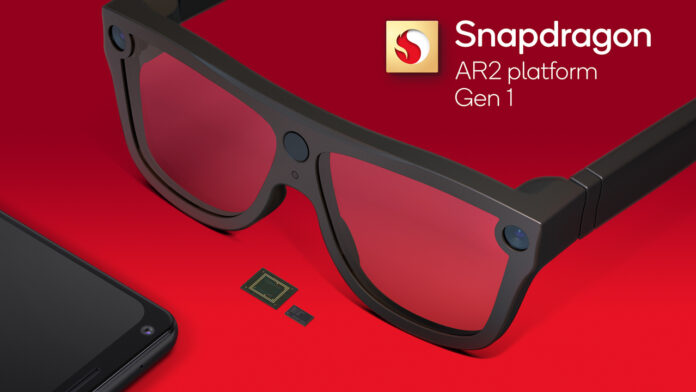Qualcomm wants to change the story around augmented reality (AR) glasses. To date, most models have been chunky, heavy, and restrained by poor battery life. In order to solve these issues, Qualcomm took an entirely new approach in developing the Snapdragon AR2 Gen 1 Platform, which it announced Wednesday during its annual Snapdragon Summit.
The big leap here is Qualcomm’s multi-chip distributed processing architecture. Rather than cram everything onto a single system-on-a-chip, Qualcomm broke apart the individual components and spread them around the frames of the AR2 Gen 1. This allowed Qualcomm to design slimmer AR glasses that manage to improve performance at the same time.
(Credit: Qualcomm)
The three main components are the AR processor, the AR coprocessor, and the connectivity platform. While the first two components are able to capture and process onboard sensor data, the connectivity platform ensures a speedy connection with the associated smartphone or PC, onto which it offloads the more demanding data processing tasks.
Qualcomm says the AR processor supports up to nine onboard cameras and features low latency for rapid reaction times as people move around. Hardware acceleration improves motion tracking and localization with full support for six degrees of freedom. The AR coprocessor combines camera and sensor data to assist with eye tracking and iris recognition for foveated rendering, which helps reduce power needs. Last, the Fast Connect 7800, the same Wi-Fi module found in the Snapdragon 8 Gen 2 mobile processor, supports Wi-Fi 7 with less than 2ms of latency and throughput speeds of up to 5.8Gbps.
Placing the individual modules at various points around the Snapdragon AR2 Gen 1 and offloading some compute tasks to the smartphone lets Qualcomm make some performance gains. For example, the 4nm Hexagon Tensor processor pushes a 2.5x gain in AI performance while reducing power consumption by 50% when compared with Qualcomm’s previous generation AR glasses. Importantly, this permits a 40% reduction in the size of the ear stems, which means AR glasses that look and feel more like normal glasses.
Recommended by Our Editors
(Credit: Qualcomm)
In addition to the new hardware, Qualcomm has worked with various partners (Microsoft in particular) to ensure there is a space for developers to create for the AR2 Gen 1 glasses. The Snapdragon AR2 and Snapdragon 8 Gen 2 are optimized for the Snapdragon Spaces Ready Developer Platform, which was designed to help developers reimagine what AR glasses can do. Qualcomm says companies such as Lenovo, LG, Oppo, Sharp, TCL, and others have expressed interest in the platform and are actively developing around it.
The company didn’t say when products based on the AR2 may reach the market.
Get Our Best Stories!
Sign up for What’s New Now to get our top stories delivered to your inbox every morning.
This newsletter may contain advertising, deals, or affiliate links. Subscribing to a newsletter indicates your consent to our Terms of Use and Privacy Policy. You may unsubscribe from the newsletters at any time.
Hits: 0


















